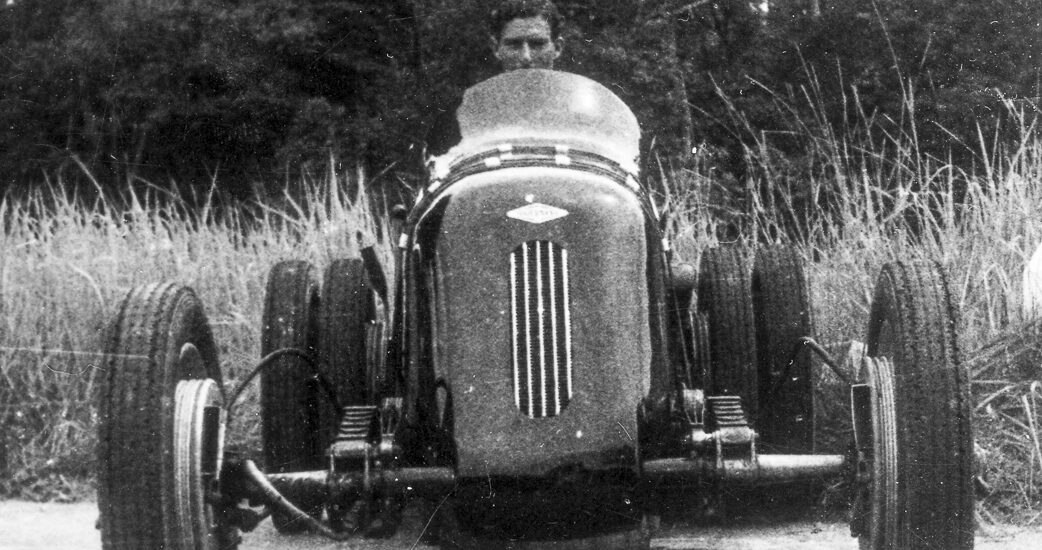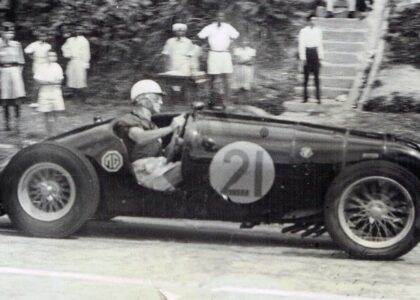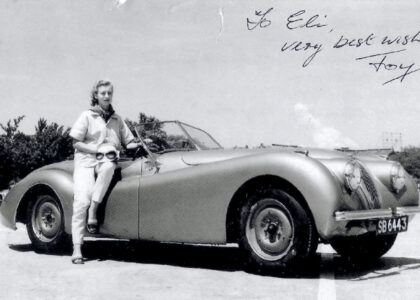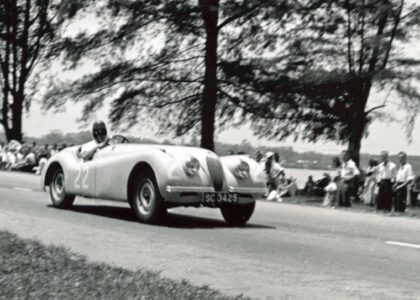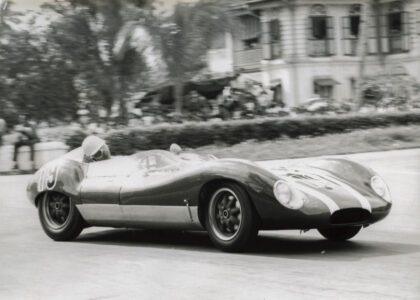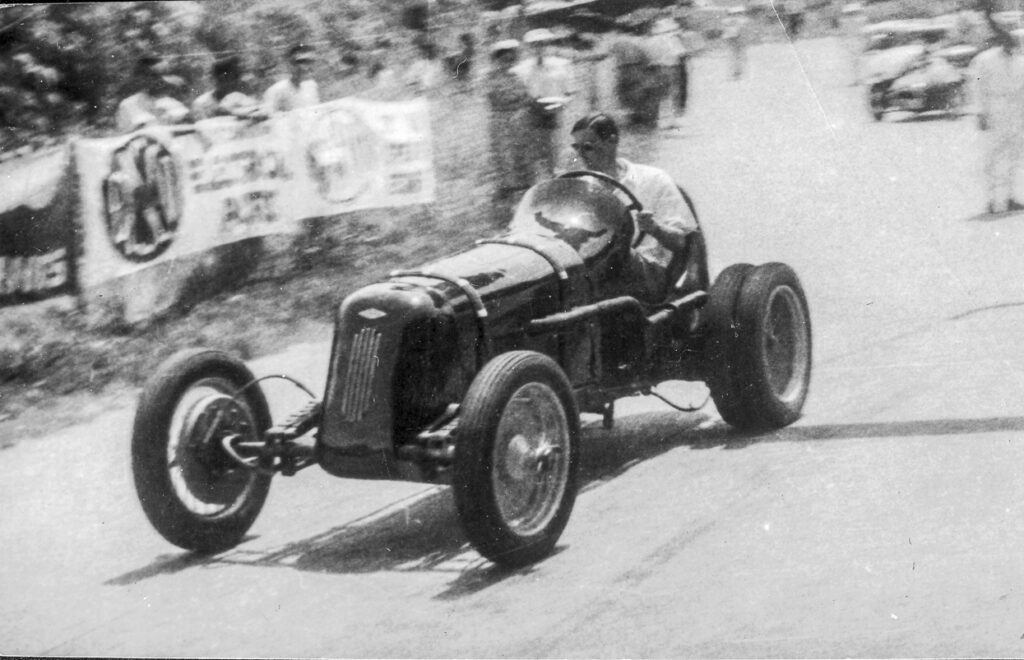
Colonel Peter Vaughan in action at the Gap Hill Climb in Singapore.
Chain Gang is a term of endearment given to fervent supporters (and owners) of pre-war Frazer Nash1 cars (and cycle cars) that had their final drives driven by chains. Pre-war Frazer Nashs are highly sought after. One car that stood out was a record-setting car owned by one of the later shareholders of Fraser Nash Company.
Alfred Fane Peers Agabeg, aka A.F.P. Fane, was born on 11 November 1911 in India to Major A.A. Agabeg, a mining engineer. Educated at Harrow and Cambridge, Alfred’s interests encompassed all things motoring. Determined to race competitively, he ordered a Frazer Nash (chassis 2040) in 1932 and designed a two-seater body which English coachbuilders Corsica2 built for him. The Agabeg family name was unusual and he soon changed his name to Alfred Fane Peer Fane, signing his name as Fane Fane. He was close friends of the owners of Frazer Nash Cars, which eventually led to him to becoming a shareholder of the company in 1935. The company was known as AFN Ltd. by then. He also joined the company full-time as a ‘Salesman and Demonstrator’, and was the unofficial works racing driver3.
In June 1935, AFN Ltd. completed a single-seater for a customer using chassis 2155 (engine 7/121), but the car, sporting a 4-cylinder overhead camshaft Albert Gough 1499cc engine with twin Centric Superchargers and twin SU carburettors, did not come up to expectations after four starts and four engine failures. A deal was struck and the factory bought it back for Fane to race it as a Works entry. Attention to the engine resulted in success in Fane’s hands with a 1500cc record around Brookland’s Mountain Circuit that year. Albert Gough continued to work on the engine as Fane raced it at Brooklands, Shelsley Walsh, Brighton and Southsea over the next three years and it invariably finished in the top three.
While many swear that a Gough-engined Frazer Nash is the purest form of the breed, the Gough single overhead cam engines were however unreliable as they were underdeveloped due mainly to budget considerations. During the day, the factory claimed an output in excess of 150bhp in supercharged form. The logic of using a chain-drive was sound – the power losses in the transmission were less than that of a conventional gearbox and transmission, and this meant that the Gough 1499cc engines were a match for the ERA 1½-litre Grand Prix cars.
In 1936, the Fane Frazer Nash lapped Brooklands’ outer circuit at 121.77mph! At the Shelsley Walsh Hill Climb in 1937, Fane set Fastest Time of Day. There was a major rebuild before the 1939 race season, the engine and driving position was revised (rearwards). There was also new coachwork – a narrow radiator cowl and high tail were the main visible alterations. Further modifications were done after WWII when the car was acquired by Major Charles Peter Vaughan4.
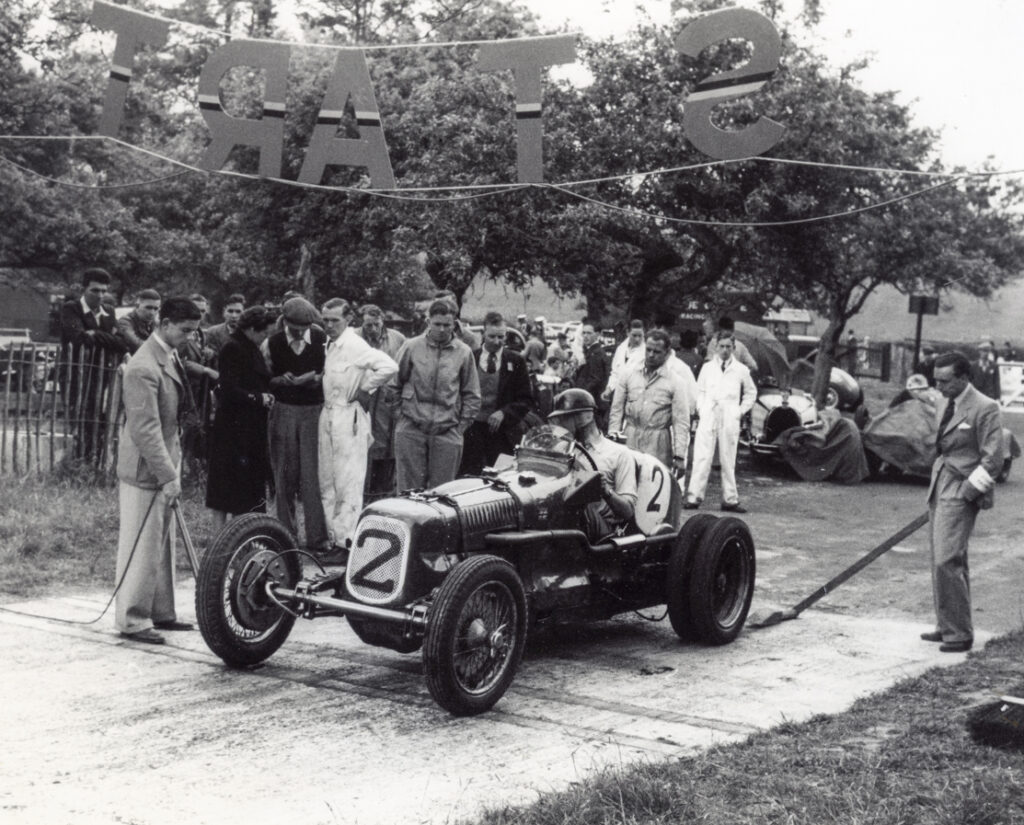
AFP Fane in the Fane Frazer Nash at Prescott in 1938. The car had yet to undergo major revisions – where the engine and driving position was moved rearwards and coachwork added – a narrow radiator cowl and high tail were the main visible alterations. Image: Ferret Fotographics
NEW BRUSH
NEW BRUSH: Vaughan joined the Junior Car Club (JCC) in 1928 at the tender age of 17 and became something of a hill climb specialist. His exploits at Shelsley Walsh before and after the war are less known amongst us. When he was posted to Malaya in 19505, he acquired Peter Liddell’s6 1911 Rolls Royce Silver Ghost (road registration S7990) in the latter part of the year7.
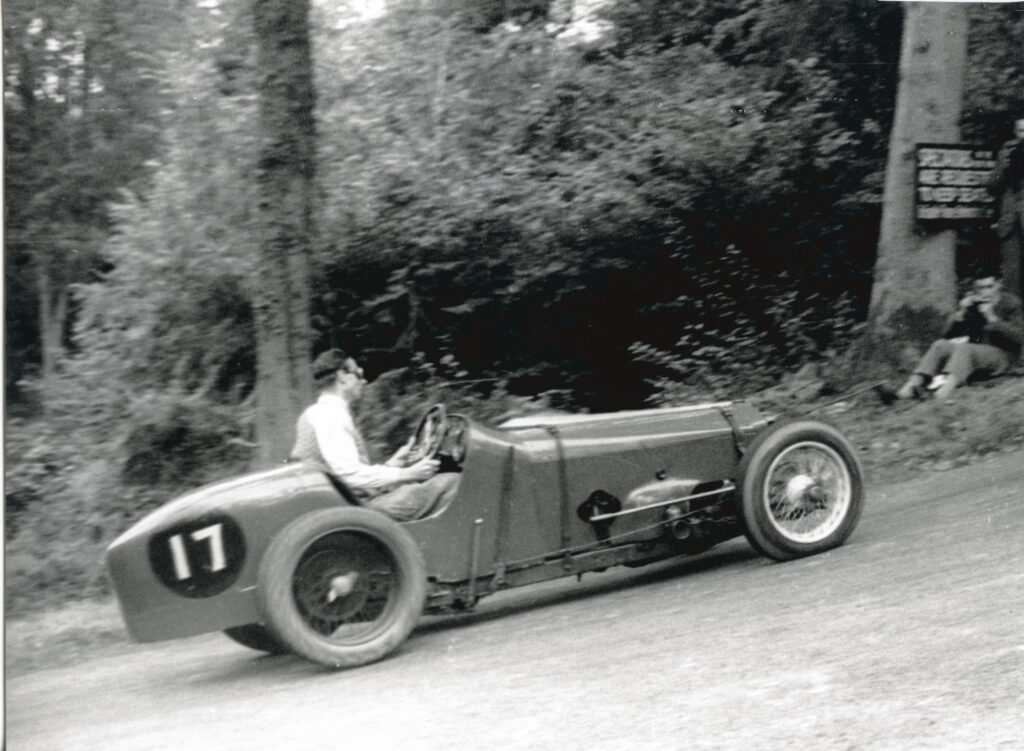
Little was known of Peter Vaughan’s hill climbing expertise when he first arrived in Malaya in the early 1950s. He was already an accomplished hill climbler before the war, usually in his GN Becke Powerplus, seen here at the Shelsley Walsh Hill Climb, circa 1939.
His race car, the aforementioned Fane Frazer Nash, was shipped to Singapore in August 1951 just in time for the most popular hill climb in the region, the second post-war Gap Hill Climb, held that year on 28th October. The race car sat in its crate in the muddy grounds of the harbour for a good three weeks till Freddy Pope, founding member and stalwart of the Singapore Motor Club, was able to clear the paperwork and extract the car to his Anson Road garage. The car promptly set a new record for the course (51.03 sec) and went on to become one of the most successful sprint cars in Malaya between 1951 and 1953. The car was maintained throughout by Pope in Singapore until Vaughan had it shipped back to England in July 1953.
TRAVELLING COLONEL
TRAVELLING COLONEL: Sandhurst-educated Vaughan’s association with Singapore and Malaya began in 1950 when, as a Major and Second-in-Command, he arrived in Singapore with the advance party of the 1st Regiment as part of the push to eliminate the communist threat to Malaya. It was at the height of the Malayan Emergency that Vaughan greeted his troops at the dockside in Singapore when they landed on 18 June 1950.
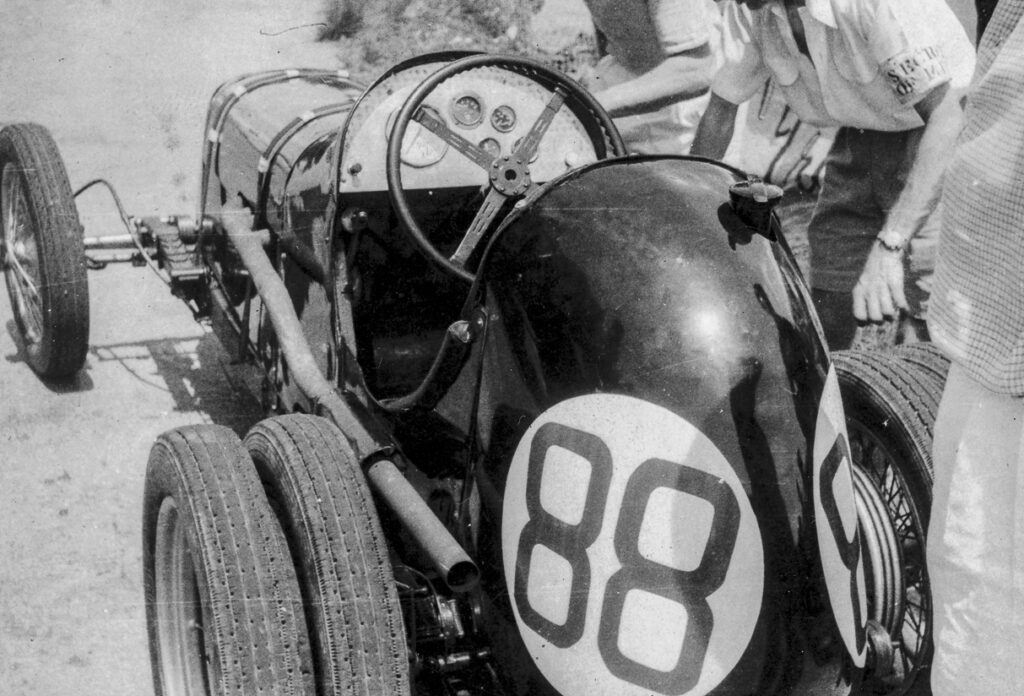
The Frazer Nash with its four rear wheel setup in Singapore.
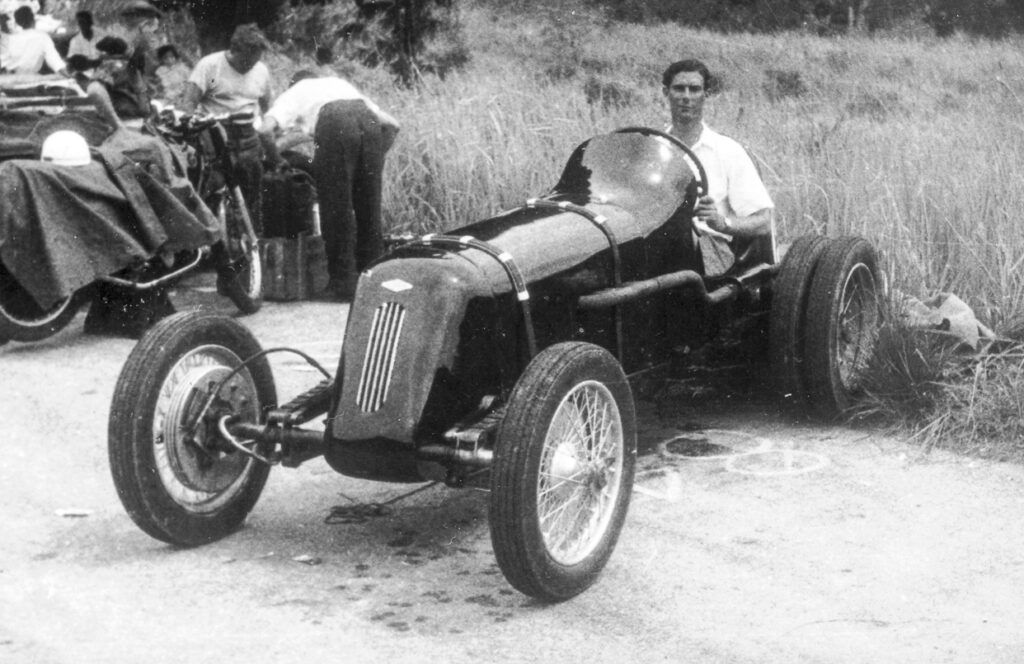
Colonel Peter Vaughan ready for a hill climb in the Frazer Nash.
The battalion was posted to Sungei Patani in Kedah, Malaya, late in July 1950 before being reposted down to Segamat in Johore in early October that year. His regiment were active up and down the Peninsula. Now holding the rank of Lieut.-Colonel, he left the Battalion on appointment in July 1951 as Deputy Commandant (G.S.O. 1) of The Royal Hong Kong Defence Force. Posted back to the United Kingdom in command of the 1st Battalion, he left Hong Kong on 31 July 1953. This explains why there are references to Vaughan coming from as far as Hong Kong as well as why his friends were seen racing his Frazer Nash in Malaya and Singapore – Major Edward ‘Tug’ Wilson8, Major R.B. Davis, Major Viscount Hanworth9, GHQ, FARELF, and, of course, Freddy Pope.
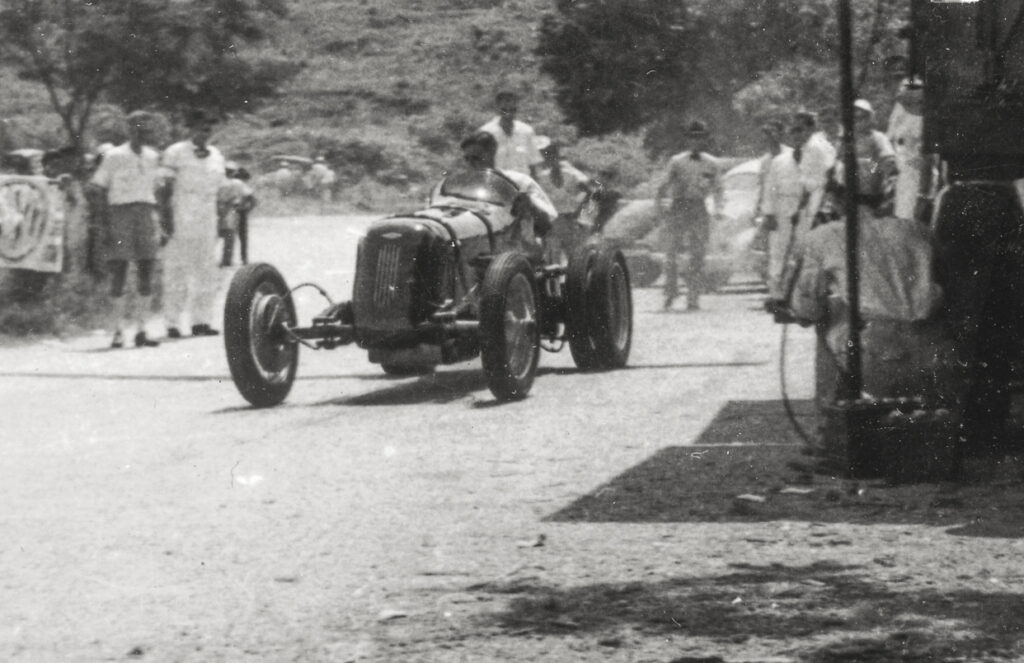
The black single-seater was a lean and purposeful-looking machine with its twin tyres on special, wide, rear wheels.
Vaughan’s departure from the Far East in July 1953 robbed Malaya and Singapore of one of its most fervent and successful competitors. There was an opportunity for regional competitors to acquire this fabulously successful Frazer Nash but it was but a fleeting one. In April 1953, the car was offered for sale10 by Vaughan while it was squatting at Pope’s garage in Singapore. As it turned out, Vaughan instructed Pope to ship the car back to the UK once his posting was confirmed. During its short stint in Singapore, the car was raced in no less than eight club events, setting FTD on four of those occasions. Thus ended the short stay in Singapore of the single-seater Fane Frazer Nash.
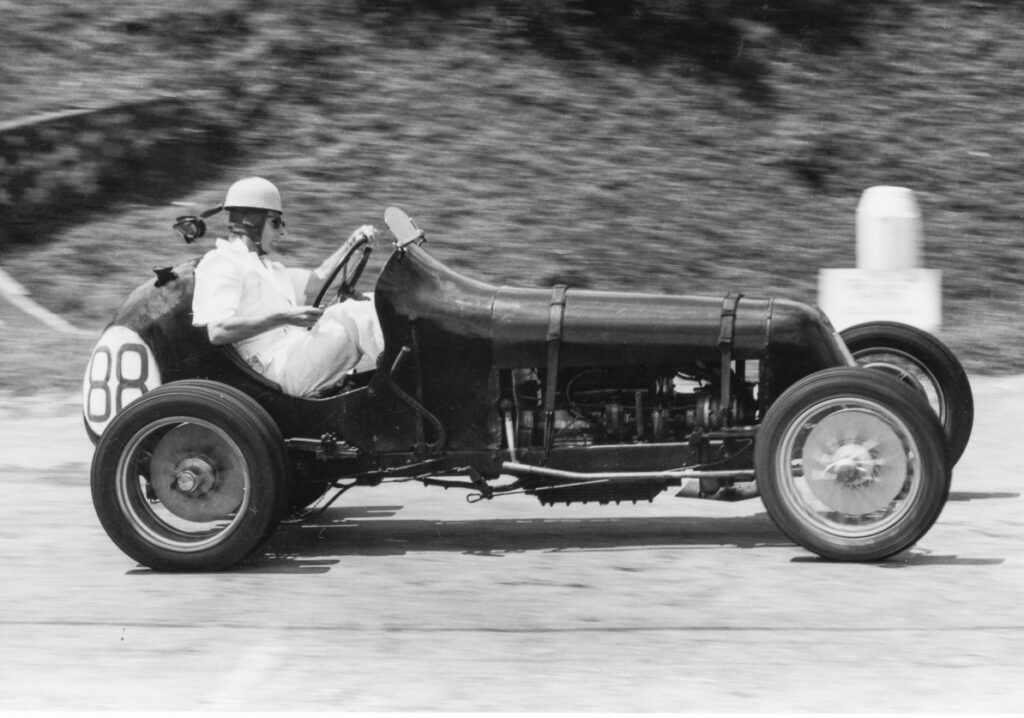
Moments before disaster at the Gap Hill Climb on 5 April 1953.
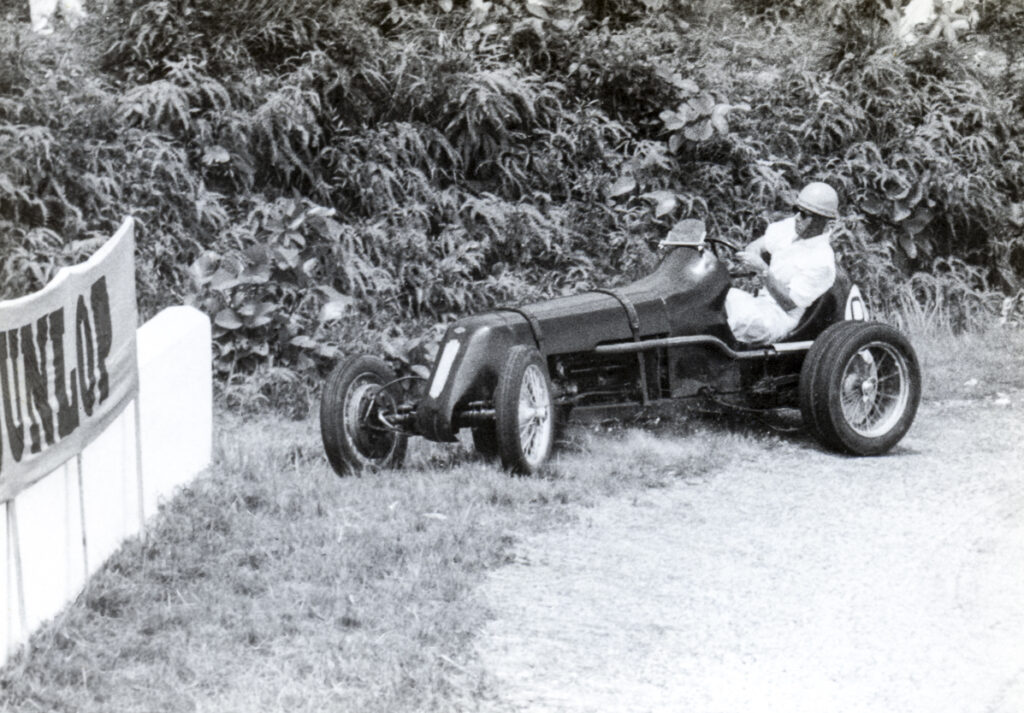
At the Gap Hill Climb held on 5 April 1953, the Frazer Nash, running a four-wheel rear, set FTD but the car came to grief before the second driver Major Viscount Hanworth had his chance to drive it.
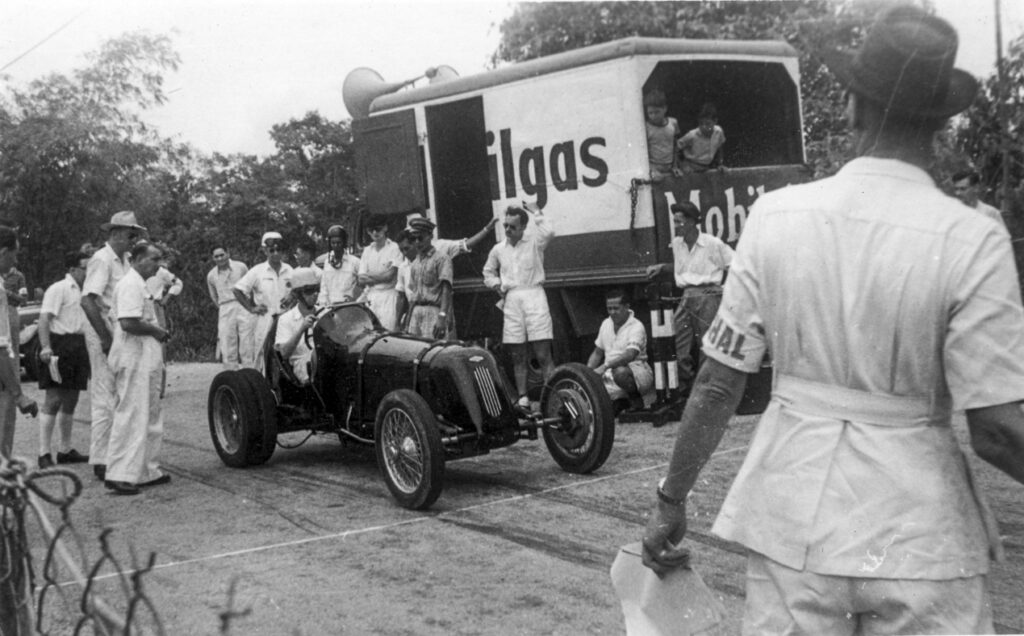
The rear wheels would spin furiously even before the car started to move off the line and Vaughan had to keep his eyes glued to the tachometer in order not to blow the engine.
The Frazer Nash’s records in Malaya
28 October 1951 – Gap Hill Climb – FTD at 51.03s. C.P. Vaughan (FTD)/E.B. Wilson – #88
24 February 1952 – Dunearn Flying Kilo – FTD at 27.61s. E.B. Wilson/Major R.B. Davis (FTD) – #88 [Note: Clutch disintegrated during R.B. Davis’ run]
11 May 1952 – Gap Hill Climb – 50.15s. C.P. Vaughan/Freddy Pope – #88
1 June 1952 – Malacca Half-Mile Speed Trial – FTD at 33.75s. Major R.B. Davis – #35
6 July 1952 – Lim Chu Kang Half-Mile Sprint – 25.13s. Freddy Pope/Major R.B. Davis
5 April 1953 – Gap Hill Climb – FTD at 48.20s. C.P. Vaughan – #88 [crashed]
14 June 1953 – Dunearn Kilo – 29.89s. Freddy Pope – #88
18 October 195311 – Gap Hill Climb – Not known – Freddy Pope – #88
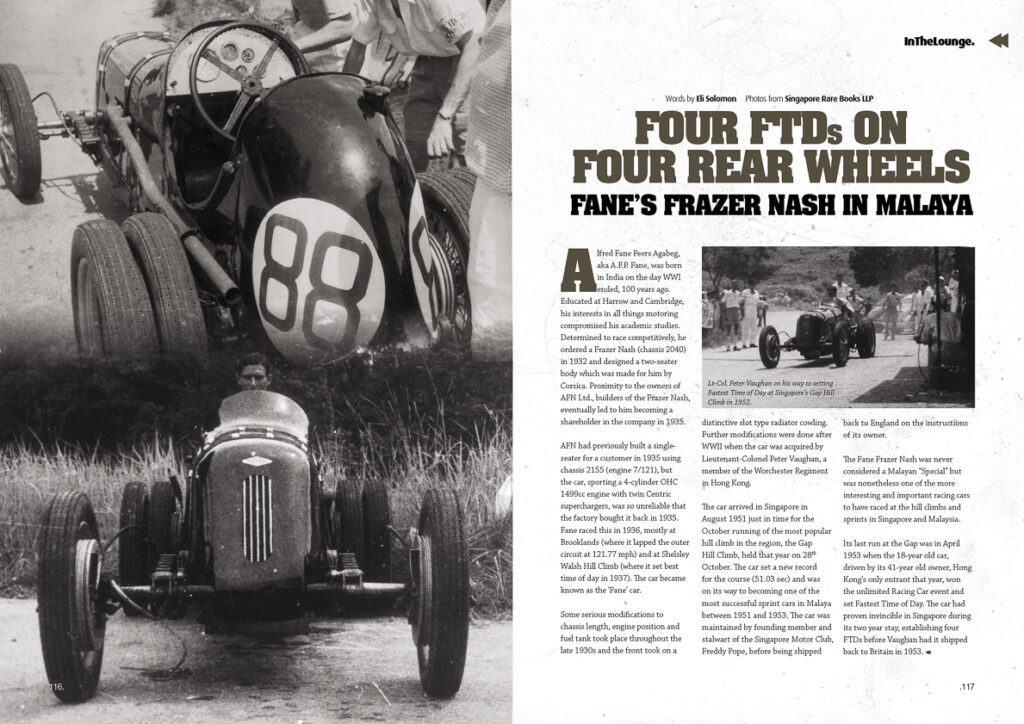
The Malayan Frazer Nash story first appeared in Rewind Magazine 006, April 2011.
Words by Eli Solomon
Footnotes
- Frazer Nash owners were known as the Chain Gang with what respected motor sport journalist and historian Denis “Jenks” Jenkinson referred to as “a fearsome reputation for their competitive approach to life, both on and off the track.” The spelling of the name Frazer Nash is not hyphenated.
- West London-based coachbuilder Corsica specialised in racing bodywork and bespoke bodies made to a high standard.
- From Chain Drive to Turbocharger – The A.F.N. Story by Denis Jenkinson. Patrick Stephens Limited (1984).
- Charles Peter Vaughan was born 17th July 1911, the elder son of Lieut.-Colonel P. E. Vaughan, D.S.O., who also served in The Worcestershire Regiment. Educated at Sherborne and R.M.C. Sandhurst, he was commissioned in to the 1st Battalion The Worcestershire Regiment in 1931 at Crownhill Barracks, Plymouth and served with the Battalion in that station and at Aldershot until 1936 under the command of Lieut.-Colonels J. F. Leman and S. A. Gabb. From 1937 to 1939 he was adjutant of The Regimental Depot at Worcester under the command of Majors E. L. G. Lawrence and R. H. Melville Lee.
In 1939 he transferred to the Welsh Guards with whom he served until 1942 when he was seconded to The Royal West African Frontier Force initially as a company commander in the 7th Nigeria Regiment, commanded by Lieut.-Colonel A. H. Gillmore of The Worcestershire Regiment, and in Brigadier H. U. Richards’ Brigade. Later in Burma when Colonel Gillmore was in command of the Brigade, Peter took over the Battalion and commanded it in General Orde Wingate’s Second Chindit Campaign in Burma. He was wounded in June 1944 and was awarded the D.S.O. for gallant and distinguished service while in command in Burma. He transferred back into The Worcestershire Regiment in 1946. After a tour of duty on the staff at Headquarters, B.A.O.R., he went to the Staff College in 1947. On conclusion of his course there he returned to H.Q. B.A.O.R. as D.A.Q.M.G. for a two year tour.
He rejoined the 1st Battalion as Second-in-Command to Lieut.-Colonel A. H. Gillmore in Gottingen in 1949 and remained with the Battalion in this appointment during their short stay in the U.K. in the spring of 1950, before sailing on 19th April from Southampton for Malaya in charge of the Battalion Advance Party. Four days before sailing he was on parade on the County Cricket Ground at Worcester when the Regiment received the Freedom of The City and the gift of the Silver Drums. He also took part in the ceremonial march through the City and was present at the dedication of the War Memorial in St. George’s Chapel in the Cathedral on the same day.
He continued in his appointment as Second-in-Command for the first year of the Battalion’s tour of duty in Malaya during the emergency and took part in a number of operations against the Communists. He left the Battalion on appointment in July 1951 as Deputy Commandant (G.S.O. 1) of The Royal Hong Kong Defence Force in the rank of Lieut.-Colonel. He arrived at the Colony just in time to be confronted with all the problems resulting from the introduction of the Compulsory Service Ordinance and involving the reorganisation of the Headquarters of the Force. He was also much involved in the Colony’s Coronation Celebrations in May 1953, but his tour of duty ended shortly afterwards and he left Hong Kong on 31st July that year en route for the U.K. and command of the 1st Battalion in succession to Lieut.-Colonel (later Brigadier) P. H. Graves-Morris. He took command of the Battalion in Bulford on 25th November 1953 and it was not long before he was immersed in the rigours of training on Salisbury Plain. His early months in Command also saw a ceremonial parade in commemoration of the 260th anniversary of the raising of the 29th Foot, followed by the inevitable normal requirements of the U.K. training cycle. He was married to Jean and had two sons and three daughters. Lieut.-Colonel Charles Peter Vaughan, died 15th November, 1975, at the age of 64.
- This is contrary to the original belief that he was based in Hong Kong throughout the period.
- Peter Desmond Oswald Liddell was the regional technical service representative for Dunlop in Malaya. He was posted to Singapore in May 1947 and in 1948 became one of the founding members of the Singapore Motor Club (membership number 6), holding the post of Secretary till December 1950 when he went on home leave. He often did the circuit commentary for the Johore Grand Prix races between 1949 and 1952. He was the 1953 Johore Grand Prix’s Hon. Marshal. Liddell returned to United Kingdom in 1956.
- Peter Liddell features in Monsters & Mavericks – The Malayan Special.
- Edward B. ‘Tug’ Wilson [b18 Jan. 1921 d. 2 Jan. 2009], 1st Btn. Worcestershire Regiment, stationed in Ipoh in 1952. Previously based in Germany for 4 years, participated in Army and civilian trials, riding a Norton and Matchless. Wilson started the Abu Dhabi Defence Force. He participated in the London To Peking Motor Challenge in 1990.
- David Bertram Pollock, 2nd Viscount Hanworth [b. 1916 d. 1996] held rank of Lieutenant Colonel. the multi-talented Major Viscount Hanworth, was a member of the Royal Engineers stationed at Headquarters (GHQ FARELF) in Hong Kong in 1951. The Major was transferred to Singapore in 1952. A member of the Institution of Mechanical Engineers, a registered Chartered Engineer, a barrister, and an author on colour photography, he was a Fellow of the Royal Photographic Society and an avid photographer, and the first British peer to participate at a Speed Trial in Malaya, at the Lim Chu Kang Sprint in July 1952.
- Straits Times, 18 April 1953 – Lt-Col. Vaughan offers single seater supercharged Frazer-Nash racing car, which won the recent Gap Hill Climb, holds two other Malayan Course records without doubt fastest car, Malaya. Reasonable price both single twin rear wheels, tyres, spare parts. Full particulars Pope’s Garage, 69, Anson Road, Singapore, or direct from Vaughan, Royal Hong Kong Defence Force, Hong Kong.
- It was earlier thought that the Fane Frazer-Nash had shipped to England by this event but the car does appears in the program and was apparently seen by Henry A. Stonor and recorded in a letter to the MSVCR – August 1971.

